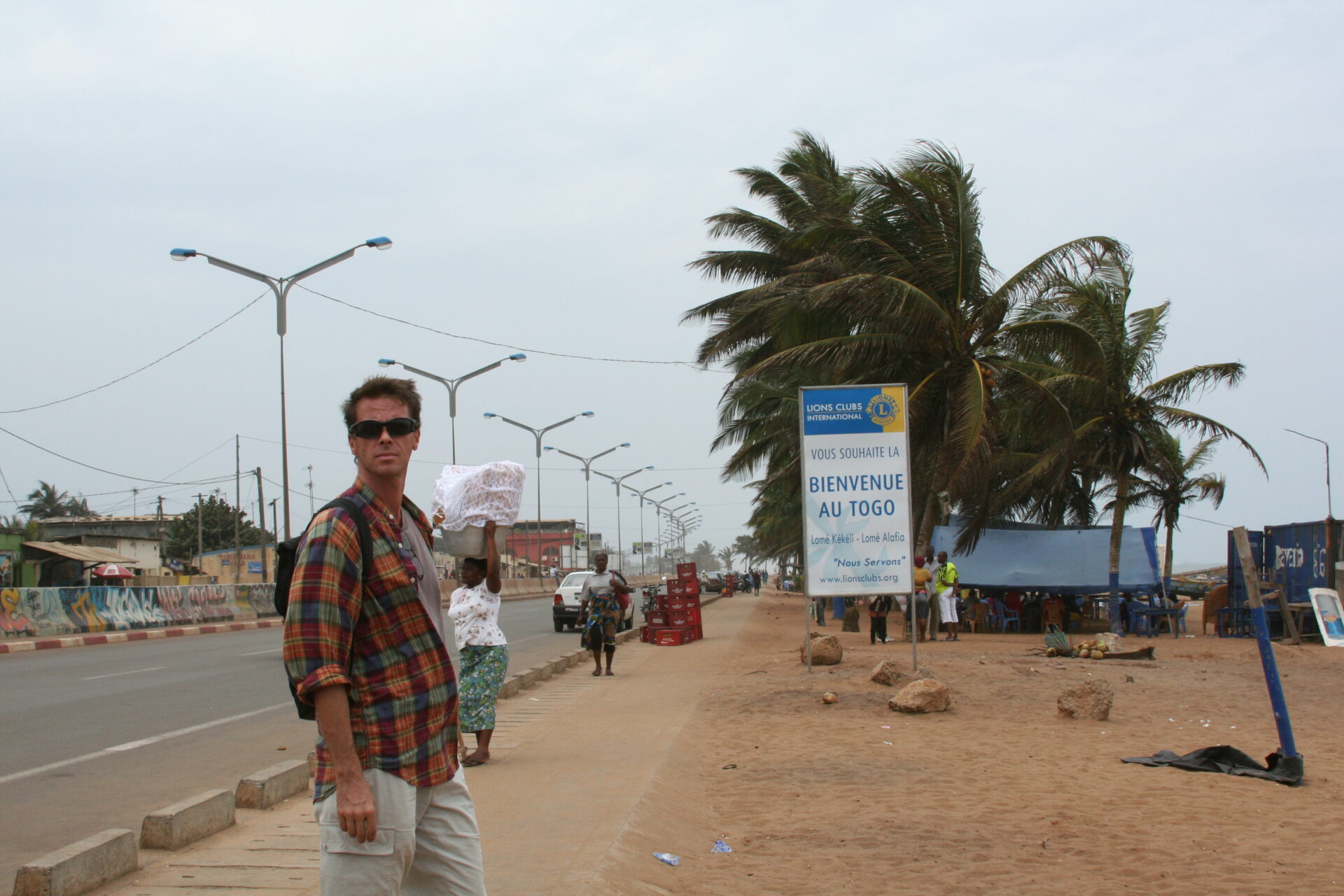During a trip to Ghana, I couldn’t resist the temptation of trying to cross the border into Togo for a long day trip from Accra, Ghana. Lucky for me, I was traveling with a like-minded friend of mine who had just completed a Peace Corps gig in Liberia, and he was happy to join me for a border crossing adventure into Togo. Here’s what we experienced during our overland trip from Accra, Ghana to Lomé, Togo.

Table of Contents
Brief overview of Togo
Togo is one of those faraway places that many people in the United States have never even heard of, let alone visited. My prior knowledge of Togo was pretty sparse, putting it mildly. I knew where Togo was on a world map. I knew it was a French-speaking country, and I knew that the capital was Lomé. Being a soccer fanatic, I was also familiar with the Togolese player Emmanuel Adebayor, and I remembered the 2010 attack on the Togo national soccer team bus as the team drove through Angola, resulting in three dead and nine wounded. But that was the extent of what I knew about Togo prior to my arrival at the border.
Togo, also known as the Togolese Republic, is a small, narrow country that is wedged between Ghana and Benin. At its widest point Togo spans only 99 miles. The country has a population of about 9 million people, with just under 2 million people living in and around the capital and largest city, Lomé. The city of Lomé is located on the Gulf of Guinea.
Prior to the 19th century, the coast of Togo was part of what was known as “The Slave Coast”, since it served as a major trade center. The first Europeans to arrive were the Portuguese (late 15th century) before it was eventually claimed by Germany in 1905 and named Togoland. During World War I, Great Britain and France invaded Togoland. To make a long story short, after World War II, Great Britain governed the western part of Togoland and France governed the eastern part. In 1957, the residents of British Togoland voted to become part of Ghana. In 1960, French Togoland officially became the Togolese Republic.
Hopefully that brief overview provides some understanding of why Ghana’s national language is English, while Togo’s national language is French.
So, what’s it like to cross the border from Ghana to Togo? Read on to find out.
Negotiating our way through the border
We met our driver at 7:30am at our hotel in Accra, Ghana. It took about 3.5 hours to drive from Accra to Aflao, Ghana – the busy border town where we’d leave our driver and proceed on foot into Togo. Of course, we first had to deal with customs, and that had the potential to be a difficult proposition given our situation. Why? Because we didn’t have a multiple entry visa for Ghana. We were only able to secure a visa from the Togolese embassy in Accra, but we didn’t have enough time to secure a multiple entry visa for Ghana before our trip. In other words, we could get into Togo, but we had no visa to get us back into Ghana.
We decided to roll the dice and give it a try. Both of us had spent time in different parts of Africa and found that almost anything is negotiable in Africa … for the right price.
We walked into the customs office at the Ghana-Togo border, explained that we wanted to spend the day in Lomé before returning to Ghana, and then we waited for what felt like a very long time. Finally, we were invited into the office of the customs officer to discuss the possibility of securing a visa for us to get back into Ghana if we decided to cross the border into Togo.
The officer explained the difficulty of getting a visa on such short notice, and finally said that he could arrange for us to receive an “emergency visa” for the price of US$150 each. Cash of course. That was a deal breaker for us, and we explained that it was too much money. After further consideration, the customs officer revised his approach and said he would give us a tourist visa for US$50 each, instead of an emergency visa. We agreed.
The only catch was that the Customs Officer would have to hold on to our passports, and we would need to find this officer again when we were ready to cross back into Ghana. Feeling lucky? Well, we must have felt lucky because we said yes, even though we both knew that handing over a passport is rarely a good idea. But, we figured the officer would want to collect the money, so it would all work out somehow.
Two minutes later, we were walking across the line that separates Ghana from Togo.

Noticeable differences across the border
There were two major changes from Ghana that we noticed immediately. First, English was now useless. In Togo, you speak French. Thankfully, I studied French for quite a few years and had lived in a French-speaking part of Switzerland for a short time. More importantly, I still remembered enough French to get by. It’s not always pretty, but I know enough to get around.
The second major change we noticed was motorcycles. A lot of them. In Ghana, motorcycles were banned, but in Togo, pas de problème!

Here are a few photos of Lomé.



French food in Togo
Given it’s French history, we not surprisingly ran into a French restaurant called Le Galion. It appeared to be popular with expats from France.


An elaborate diabetes scam
We spent the day exploring Lomé, although a good chunk of our day was spent dealing with a “diabetic” guy who said he needed money for an insulin shot and asked us to go with him to a pharmacy. He said he worked for a big oil company, and he forgot to bring his insulin. This insulin request was a new one to add to the long list of scams that I’ve encountered in different parts of the world. However, I have to say it was a very convincing performance. We both bought into it at first. He proceeded to send us an email from his phone with his contact information to apparently demonstrate that he was legit. Then, he took us to a police station so that he could ask them where we could find a Pharmacy that was open today.
After visiting several pharmacies that were closed, we finally arrived at one that was open. We walked in and he proceeded to buy a “temporary insulin” shot that would keep him going for a few hours until he was able to get enough money to buy a longer supply of insulin shots. He grabbed the temporary insulin syringe from the pharmacist, pulled up his shirt, stuck the needle in his side, and injected the insulin. Like I said, this was not your average scam. We started reaching for our wallets to buy him the shots that he said he needed, thinking that $10 should cover anything that he would need.
However, the pharmacist said a number in French that made me think I wasn’t understanding him properly. It sounded like a big number. The pharmacist punched the keys on a calculator and showed it to us. The total cost would be 124,131 West African CFA Franc. We borrowed the calculator to convert the number from West African CFA Francs to US Dollars, and then our jaws dropped. US$250.
Now, we both knew that US$250 was a LOT of money in most of Africa. That’s more money than many families earn in a year. And, of course, it would need to be paid in cash. Credit cards were not accepted at the pharmacy. We didn’t have that kind of cash with us, even if we wanted to pay that much money. Of course, he didn’t hesitate. “Let’s go to an ATM to get some cash”, he quickly suggested.
At this point, my friend and I were very reluctant to continue. As we walked along the streets, the patient was starting to “feel sick” and went into a … must … get … more … insulin … kind of routine. We were now 99% sure this was a scam. However, that 1% chance of not helping a person in need can sometimes be enough to cave in and hand over some money. Unfortunately, the majority of people in Africa are in need of some kind of help, so there are endless opportunities that can quickly drain your wallet.
Despite our skepticism, we went with him to an ATM. Thankfully, in this case, very few ATMs in Ghana and Togo accept MasterCard, which happened to be the only credit card that I had with me, so we weren’t able to withdraw any money even if we wanted to. We gave our friend a small amount of cash (US$10), wished him well, and hailed a taxi to get out of there.
At least our tour of Lomé pharmacies gave us the opportunity to see some of the city.
Crossing back into Ghana from Togo: A fist fight saves us money
As for getting back into Ghana, we were lucky. Very lucky. The customs officer who was bribing us … I mean … arranging for our tourist visa back into Ghana, was not in the office when we returned. He’d been called into the street to deal with a fist fight at the border. We waited for over an hour until finally, an Assistant was able to make contact by cell phone with the customs officer to get the scoop on what to do with us. The Assistant was directed via cell phone to provide us with a tourist visa. The Assistant hung up the phone and told us the total would be 35 Cedi for the two of us. Cedi is the currency of Ghana. At the time, 35 Cedi was equivalent to about US$17. This was quite a change from the $50 each we’d been quoted by the original customs officer. We quickly paid, received our passports that had been stored in a desk drawer, and eagerly walked into Ghana, hoping to avoid being spotted by the Customs Officer.
We found our driver (we’d hired him for the entire day), hopped in his car, and made our way back to Accra.
Our Togo adventure was a success, at least in terms of having a memorable experience! It really was a fun trip, though. We had lots of laughs, particularly after it was over.
Here’s a photo of some of the typical scenery on the drive back from Togo to Accra.

Thought for the Week
Keeping with the border crossing theme, here’s a quote from Spanish and Puerto Rican cellist, composer, and conductor, Pablo Casals.
“The love of one’s country is a splendid thing. But why should love stop at the border?”
— Pablo Casals
Thanks for reading and happy travels!
Mark (The New Mexico Travel Guy)

Mark Aspelin, The New Mexico Travel Guy (www.newmexicotravelguy.com), is a travel writer, conservation biologist, project manager, and author of two books. He’s visited over 100 countries and all 50 U.S. states—just enough to land in the Travelers’ Century Club and make choosing a favorite place nearly impossible. He’s currently on a questionable mission to visit every town in New Mexico (there are over 500) and write a story about each one, with plans to wrap it up sometime before his early to mid 100s. Mark balances his writing with conservation and project work from his home base in the East Mountains near Albuquerque, New Mexico.

